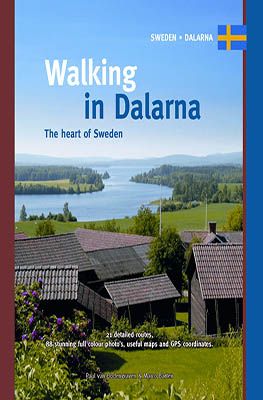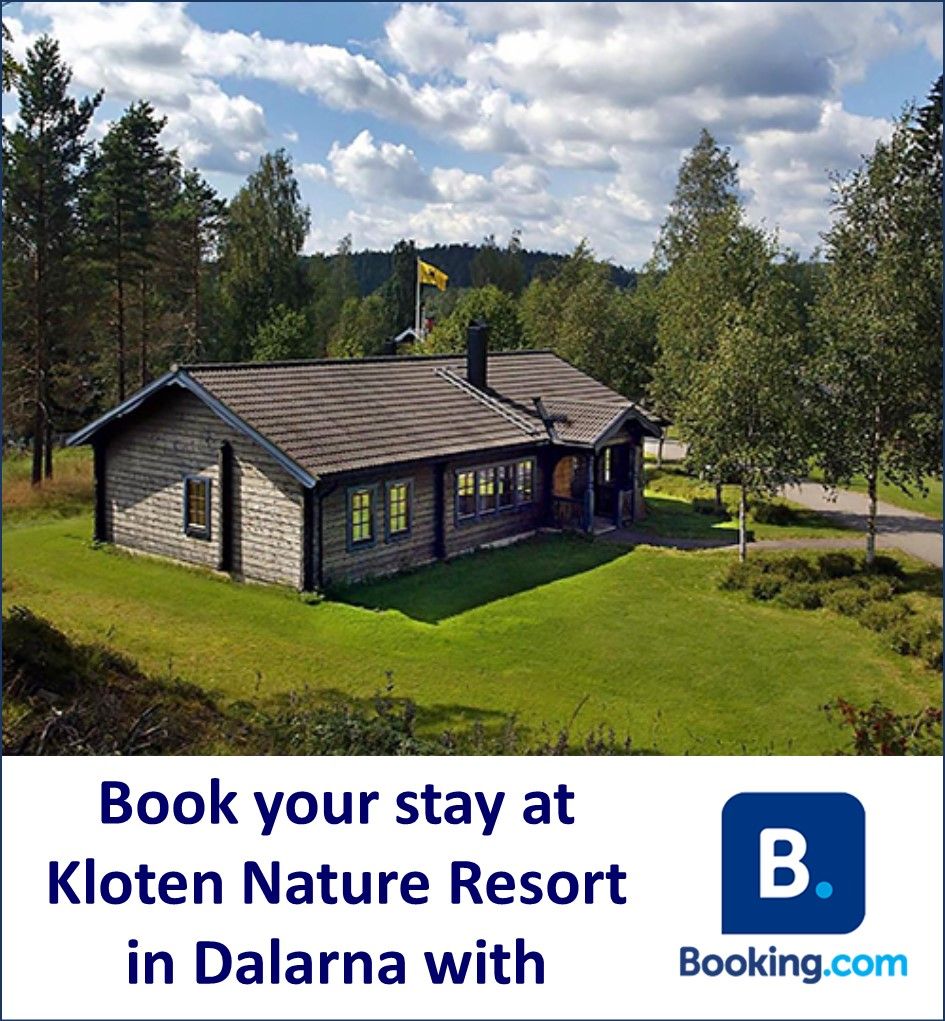As hiking and nature enthusiasts, we certainly couldn’t miss visiting Fulufjället National Park in Dalarna. We had already heard many enthusiastic stories about this nature reserve. It boasts Sweden’s highest waterfall and the world’s oldest tree as its main attractions. Additionally, the park offers numerous hiking opportunities, making Fulufjället National Park appealing to visitors, who often come in large numbers. However, during our visit at the end of August, it was wonderfully peaceful. This provided an ideal opportunity to truly take in the park’s natural beauty.
In this blog ...
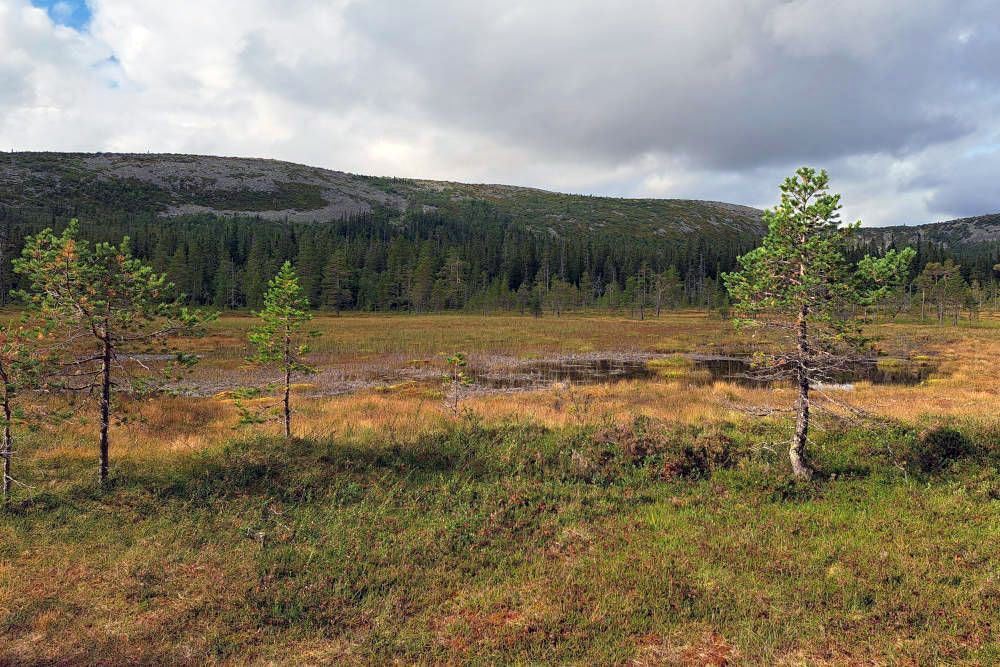
Facts about Fulufjället National Park
Fulufjället National Park is situated in Dalarna in Central Sweden. The park is mostly located in Sweden and partly in Norway, where it is known as Fulufjellet nasjonalpark. It’s home to Mount Fulufjället, which is over 1,000 meters high. The park primarily consists of coniferous forests, and the high plateau is abundant with various mosses, including the “wolf death moss.” According to tradition, this moss was placed in raw meat, which served as bait for wolves. When the wolf consumed the meat with moss, it met a slow death. Fulufjället National Park was established in 2002, making it the country’s youngest park.
The park is rich in wildlife, housing moose, foxes, wolves, and lynxes. Even the brown bear has its habitat there. Additionally, many smaller predators such as pine martens, stoats, and lemmings reside in the area. The world’s largest falcon, the gyrfalcon, may be seen circling above, searching for prey. Other birds that can be spotted include the capercaillie, black grouse, wood pigeon, pygmy owl, hawk owl, snowy owl, and the hen harrier.
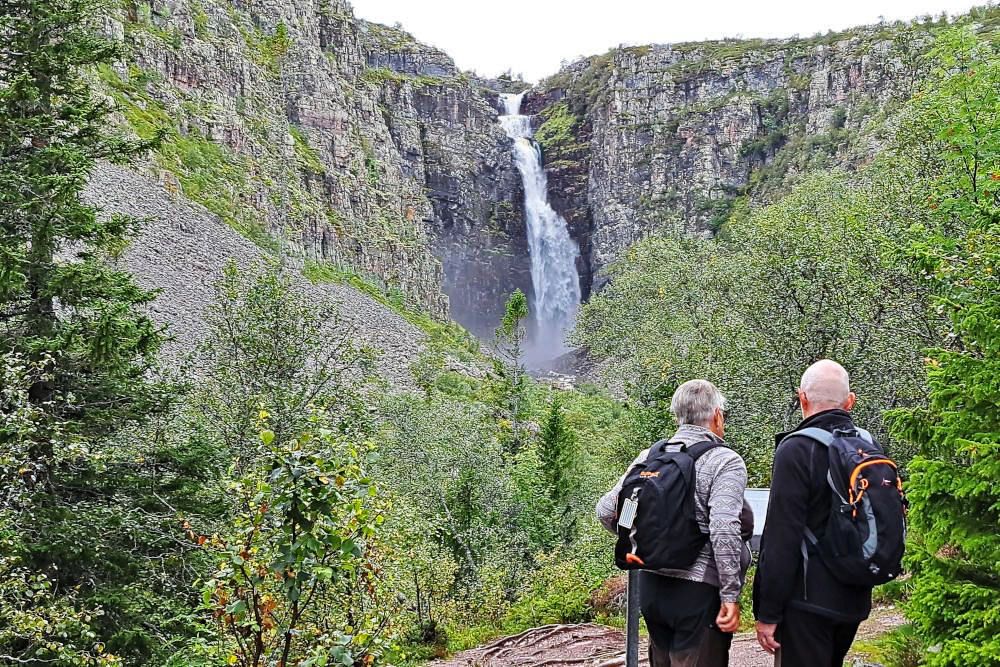
Sights and activities in Fulufjället National Park
For hikers and nature lovers, Fulufjället National Park is a true paradise. Here’s what you can see and do:
Naturum Visitor Centre
Beforehand, we had heard a lot about the park’s busyness. In addition to foreign holidaymakers, Swedes also enjoy coming here. Thankfully, that wasn’t the case today. In the parking lot, only a few hikers were preparing for their trek. Undoubtedly, the fact that we were exploring Fulufjället National Park on a weekday outside the holiday season made a difference.
First, we stepped into the Naturum visitor centre. It’s a modern building constructed with many natural materials. The staff provided us with all the information we needed. She enthusiastically described the hiking opportunities, wildlife, and highlights of the park. The photo exhibition in the visitor center was stunning, as was the view. Thanks to the large windows, we could enjoy a beautiful vista of the park from the seating area. We can imagine that this view changes every day and never gets boring. Then it was time to go outside. This afternoon, we are taking a longer walk with a guide. Therefore, we decided to take a short walk to the Njupeskär waterfall.
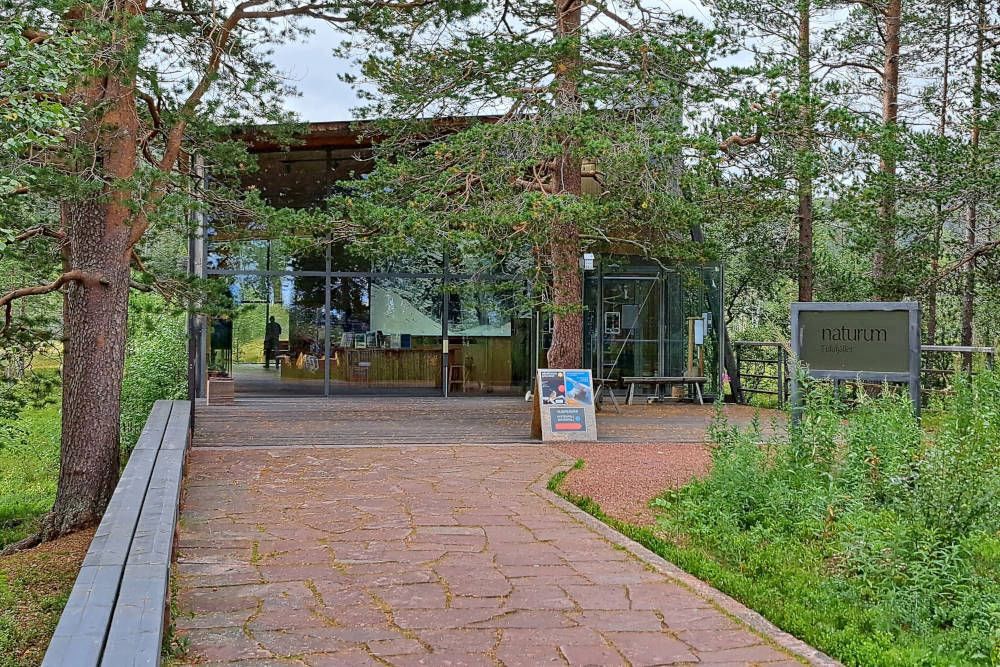
Njupeskär Waterfall
The marking of the various hiking trails in Fulufjället National Park is excellent. It’s almost impossible to get lost. We followed the yellow markings to the waterfall. Along the way, we passed a beautiful lake, heathlands, shelters, and barbecue areas. The first part of the walk was almost flat. Fortunately, there were boardwalks in some areas to traverse marshy areas without getting wet feet. Slowly but surely, we started to ascend. We crossed the Njupån river, which begins its course through the park at the waterfall. Shortly after, we reached a viewpoint. In the distance, the water thundered down.
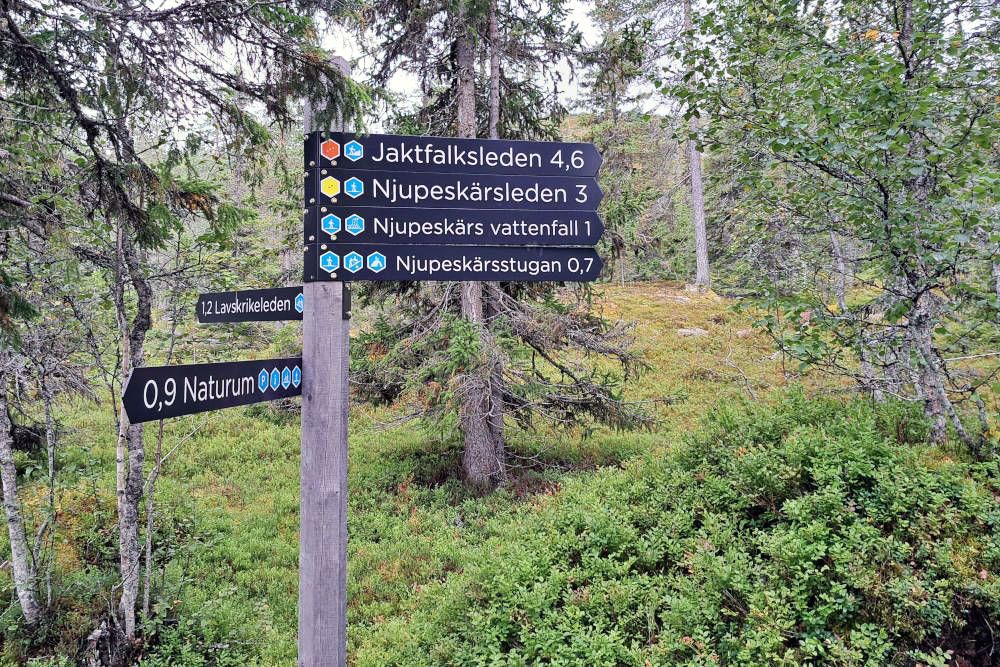
Further along, we felt the first water droplets. Not from the rain, but from the waterfall. The further we walked on the boardwalks, the wetter we became. It was an impressive sight, as the water plummeted over 70 meters in free fall. Thus, Njupeskär has Sweden’s highest free-falling waterfall. However, if you include all the small streams and waterfalls directly before and after the free fall, Njupeskär, at 93 meters, is not the highest waterfall in the country. It didn’t matter to us; it was an awe-inspiring mass of water cascading forcefully down from the mountain.
We retraced our steps back along the same route. It’s remarkable how a route you’ve already walked can look different. Afterward, we decided to have an early lunch at the Njupeskärsserveringen restaurant. We indulged in Swedish meatballs made from reindeer meat.
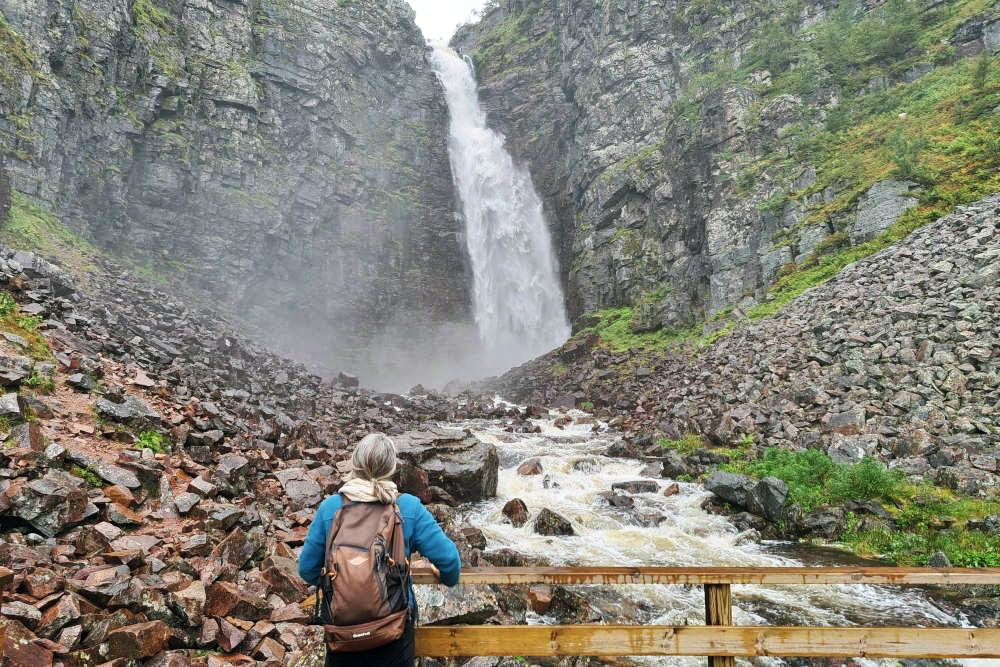
Guided Hike through Fulufjället National Park
After lunch, we set off with our guide, Daniel from Sarna Adventures. He was already waiting for us at the visitor center. This afternoon, he is taking us to see the oldest tree in the world, “Old Tjikko.” First, we walk again to the waterfall. Even though this is our third time on this trail today, it remains interesting. This is mainly because Daniel points out special plants, mosses, and other natural attractions that we hadn’t noticed before. This is what makes hiking with a guide so enjoyable.
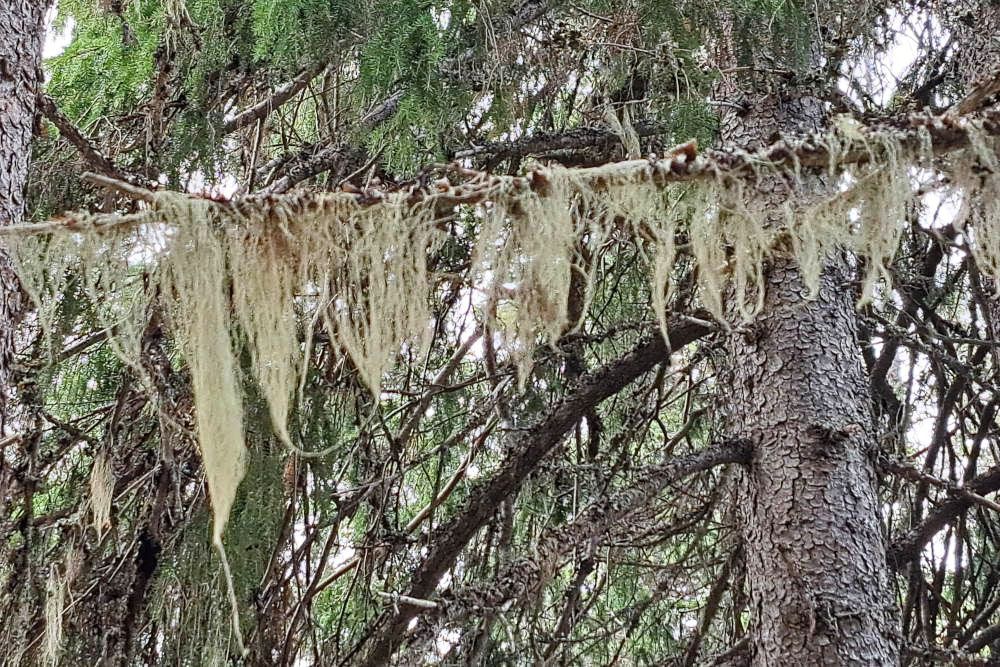
Daniel tells us that the waterfall is currently carrying an exceptionally large volume of water due to the abundant rainfall during the recent weeks’ storm. After a prolonged period of drought, the waterfall is less spectacular. From this point, we have several options for the rest of the hike. We could hike to the top of the waterfall, which involves a challenging climb with steep sections. The slippery stones make the climb even more difficult. However, a splendid reward awaits at the top with a spectacular view of the waterfall. Nonetheless, we choose to take another climb directly to Old Tjikko. Here, we also have to climb, as we head to the large plateau at the top of the park. According to Daniel, this sandstone area is about 1,500 million years old. During the climb, we frequently pause to take in the view and catch our breath.
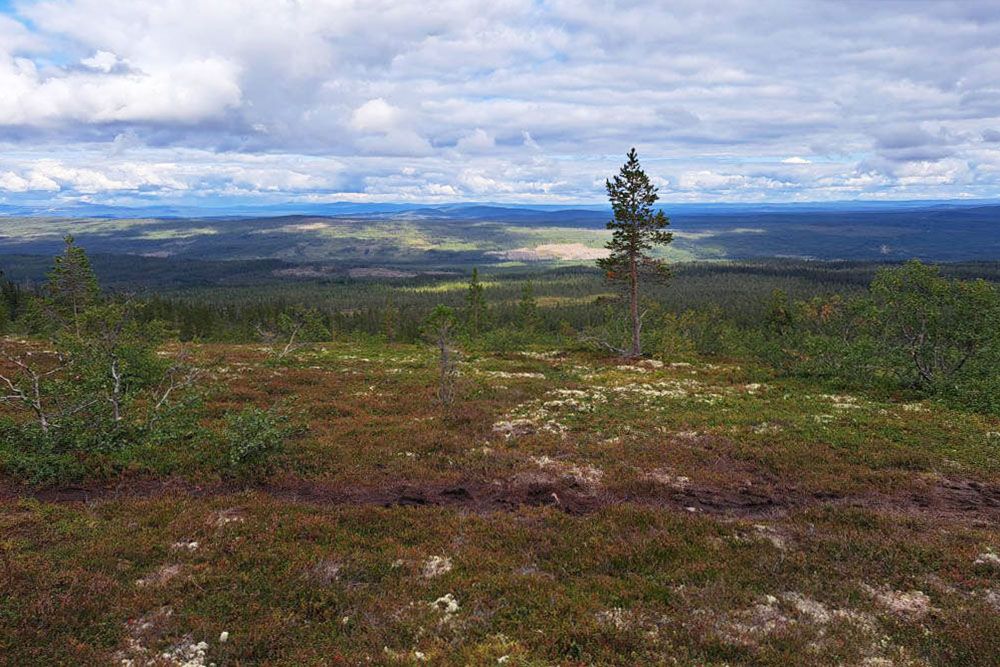
Old Tjikko, the Oldest Tree in the World
You would expect an imposing, towering green giant with a trunk that reaches to the heavens from a tree that is nearly 10,000 years old. In that respect, the initial encounter with Old Tjikko might be somewhat disappointing. This Norwegian Spruce is not much larger than the average Christmas tree in our living rooms. How is this possible? This tree has the same DNA as the trees that grew approximately 10,000 years ago. Yet, even Old Tjikko does not live forever. After about six hundred years, the trunk dies. However, the tree has the ability to clone itself. A new tree grows from the root system. Thus, according to experts, Old Tjikko is indeed the oldest tree in the world.
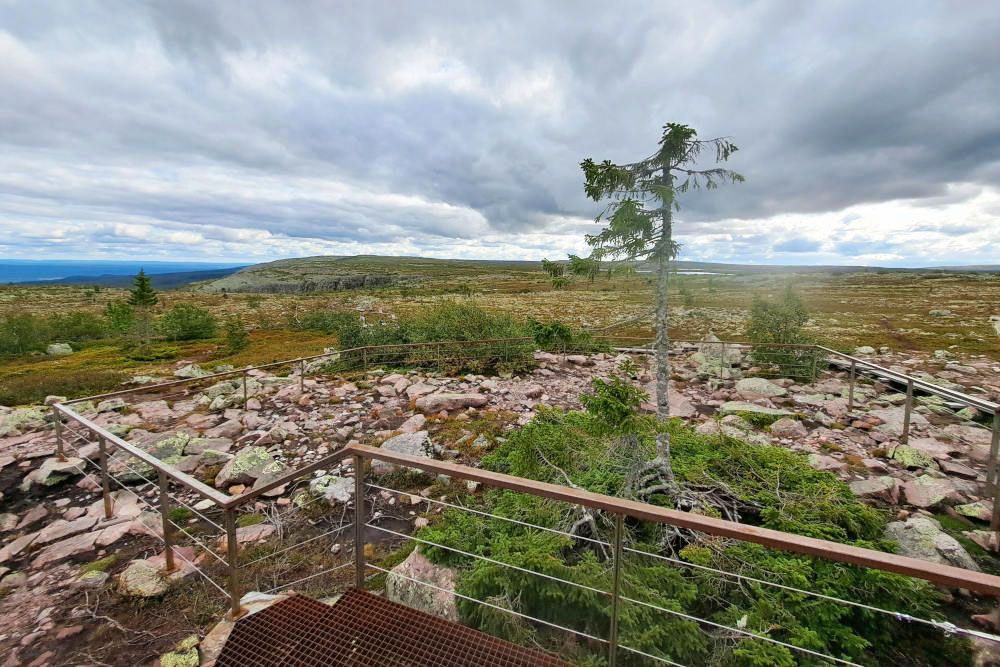
Daniel tells us that during the 2023 storm, the top of the tree broke off and blew away. It was found and has been given a place in the visitor center. The tree is named after the discoverer’s dog. He even created a website for the tree. We believe Old Tjikko is possibly the only tree in the world with its own site.
After a challenging descent over many boulders, we reach a shelter. There, Daniel prepares a fresh cup of coffee for us. With a steaming mug from the park in our hands, we once again enjoy the magnificent view. Then, we walk back to Naturum via easier paths, concluding a splendid hike. We saw a lot and learned a great deal about the park’s unique nature.
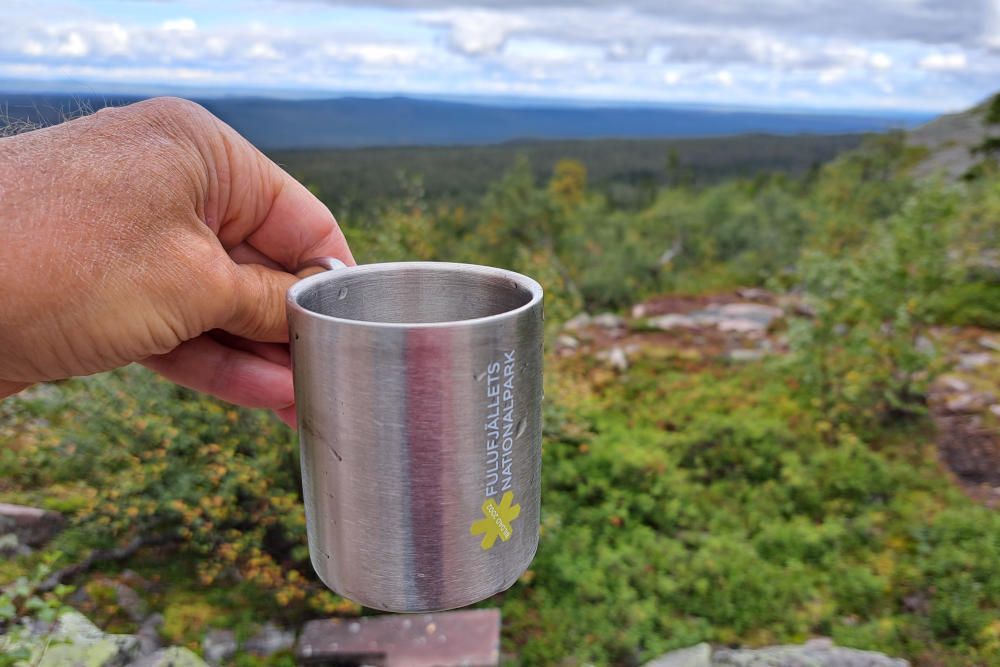
Hiking Opportunities in Fulufjället National Park
We only saw a small part of the park on foot. In total, there are 140 kilometers of marked hiking trails. The park’s website provides a complete overview of all hiking opportunities in Fulufjället National Park. There, you can also download a map of hiking routes. Free hiking maps are also available at the Naturum visitor center.
It’s possible to take multi-day trips in the park, as there are 15 cottages scattered throughout. Most are basic, but you can even rent a cottage with access to a sauna. You must bring your own sleeping bag and provisions to all cottages. However, there are cooking facilities and a wood stove for cold evenings. This is ideal for adventurers who want to truly connect with nature and don’t need many luxuries.
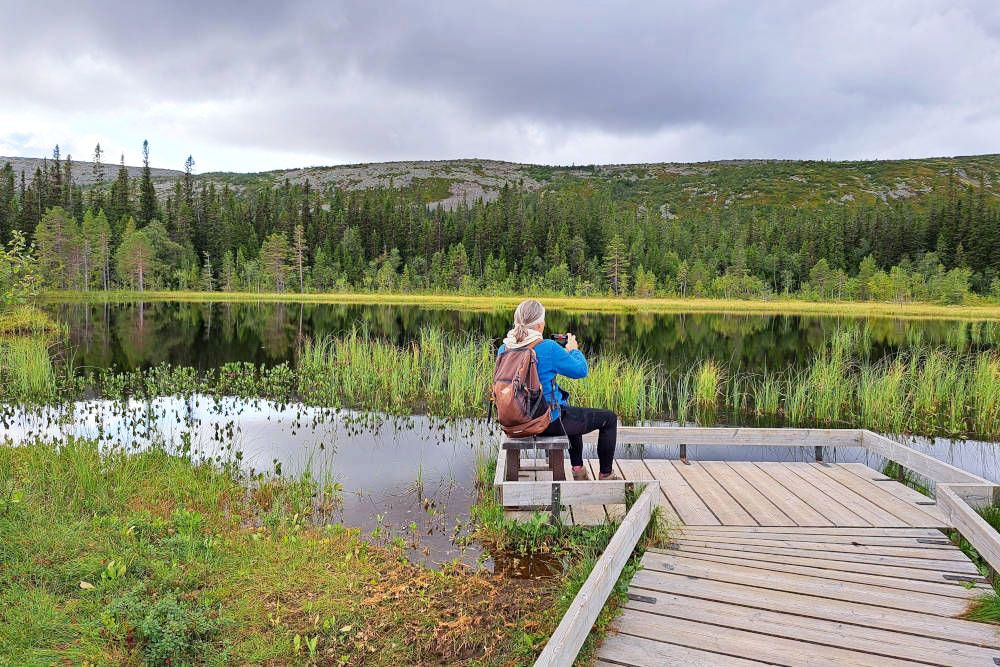
Winter Activities in Fulufjället National Park
Daniel tells us that the park is attractive to visit in every season, but his favorite season is winter. The thick blanket of snow creates a magical winter wonderland. Underfoot, the snow crunches, and the spruces are covered with a white snow coat. With the sun shining, this creates excellent conditions for outdoor activities in nature.
Seeing the Njupeskär waterfall in winter is especially remarkable. Over 70 meters of icicles pose a challenge for avid ice climbers. In the winter, you can take snowshoe walks or cross-country skiing trips in the park. Even snowmobile tours are possible. It all sounds fantastic to experience. Plenty of reasons to return to Fulufjället National Park!
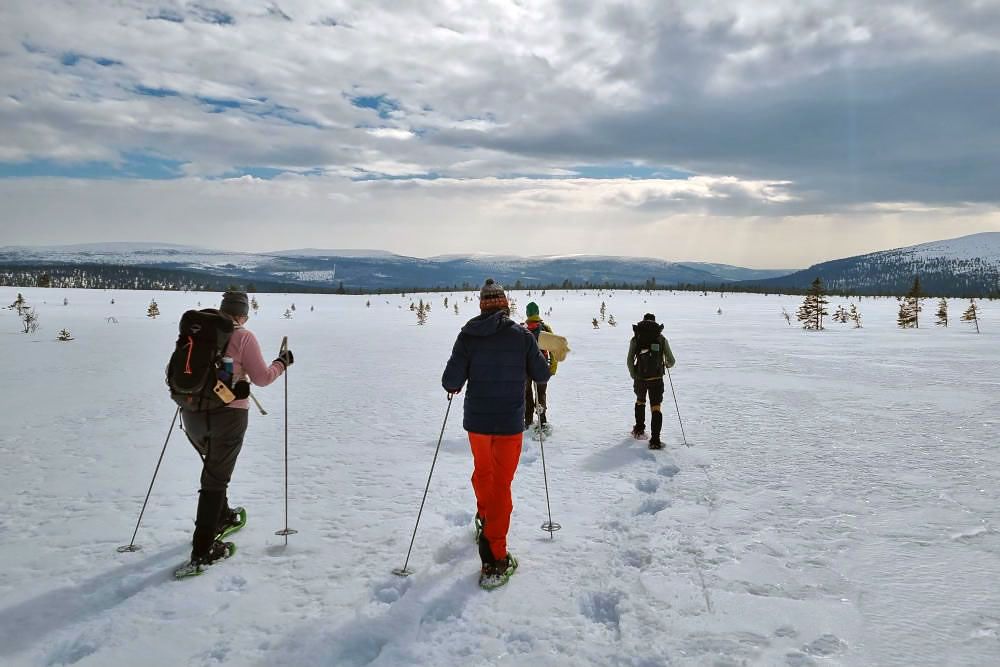
Upon invitation from Visit Dalarna, we visited Fulufjället National Park. The content of the blog has been independently and objectively compiled based on our own impressions.
Visiting Fulufjället National Park in Dalarna: What you need to know
The park is a paradise for nature lovers and hikers. Start your visit to Fulufjället National Park at Naturum, the visitor centre. In addition to providing information about the attractions and activities, there is a beautiful exhibition about the park. The park's highlights include the Njupeskär waterfall with a 70-meter free fall and the world's oldest tree "Old Tjikko". Many wild animals inhabit the park, including the brown bear. Of the numerous bird species that reside there, the gyrfalcon is the largest.
The park is a paradise for nature lovers and hikers. Start your visit to Fulufjället National Park at Naturum, the visitor centre. In addition to providing information about the attractions and activities, there is a beautiful exhibition about the park. The park's highlights include the Njupeskär waterfall with a 70-meter free fall and the world's oldest tree "Old Tjikko". Many wild animals inhabit the park, including the brown bear. Of the numerous bird species that reside there, the gyrfalcon is the largest.
The park features an extensive network of 140 kilometers of hiking trails. Several marked walks through the park start from the Naturum visitor centre.
Each season has its charm, also due to the difference in the length of the days.
- Spring in the park is relatively short. Spring doesn't start until late May. Snow often remains in May and sometimes even in June. In May, the snow melts, turning small streams into wide rivers. Usually, hiking conditions become ideal from mid-June.
- In the summer, the lakes can be warm enough for swimming. The long days around midsummer ensure that the Njupeskär waterfall is fully illuminated by the sun. June is the ideal time for birdwatching in the park. However, during the Swedish summer holidays, the park is very popular with visitors, leading to crowding, with the car park quickly filling up. Therefore, during this period, it's best to arrive early to ensure a parking space.
- Mid to late September sees the peak of autumn colours. Keep in mind that the first snow can fall early in October. For those seeking tranquillity, autumn is the most beautiful period.
- Winter lasts a long time, but it's a wonderful time to visit the park. April, in particular, is a beautiful month. The days are longer, and the sun gains strength. You can go cross-country skiing, snowshoe walking, or take a snowmobile trip along a marked winter route. The waterfall is completely frozen in winter. Snow remains until well into May. Keep in mind that it's very cold from December to February.
During the summer months, there is a restaurant next to the Naturum visitor centre where you can eat and drink. This is available from May to September. In July and August, the restaurant is open from 10 am to 7 pm. In May and September, the restaurant closes at 5 pm. If you visit the park at other times, you will need to ensure you have sufficient provisions.
There are fifteen cottages spread throughout the park. The accommodation is basic, and you need to bring your own sleeping bag and food for preparation. The beds are bunk beds in rooms with a minimum of four beds. Ideal for adventurers who want to be close to nature and do not require luxury. More information about the cottages in Fulufjället National Park.


